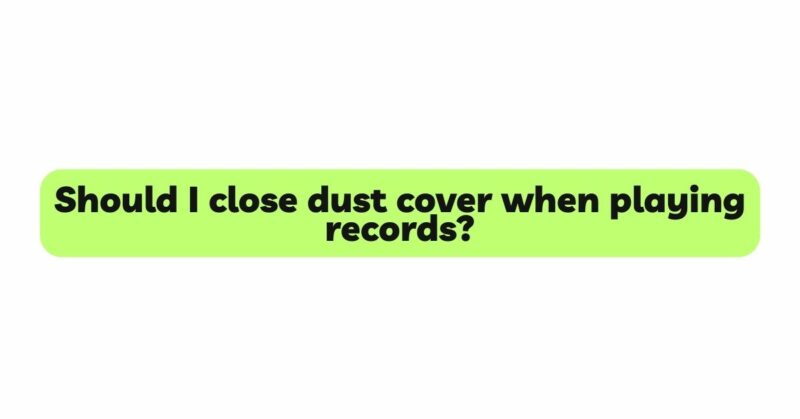Vinyl records have witnessed a remarkable resurgence in recent years, with music enthusiasts and audiophiles rediscovering the unique charm and warmth of analog sound. Playing vinyl records on a turntable is a sensory experience that fosters a deep connection to music. However, with this renewed interest in vinyl, debates have arisen about the best practices for turntable setup and maintenance. One contentious topic is whether to close the dust cover when playing records. In this article, we will explore the arguments from both sides of the debate and seek to find a balanced approach that preserves the delicate balance between protection and sound quality.
The Role of the Dust Cover
The dust cover, often made of transparent acrylic or polycarbonate, serves a dual purpose for turntable owners:
- Dust Protection: The primary function of the dust cover is to shield the turntable’s delicate components, tonearm, and vinyl records from dust, dirt, and other contaminants that can adversely affect sound quality and damage sensitive parts.
- Physical Protection: Beyond dust protection, the cover acts as a barrier against accidental damage. When closed, it guards against objects falling onto the turntable, potentially causing harm to the stylus, tonearm, or record surface.
Arguments for Closing the Dust Cover
- Dust and Contaminant Prevention: One of the most compelling reasons to close the dust cover while playing records is to prevent dust and other airborne particles from settling on the record surface. Dust particles can cause pops, crackles, and unwanted background noise, significantly degrading the listening experience. By keeping the cover closed, you reduce the risk of dust interference, resulting in cleaner sound reproduction.
- Safety and Accident Prevention: Closing the dust cover provides an added layer of protection for your turntable and records. Accidental spills or objects accidentally falling on the turntable can lead to irreversible damage. With the cover closed, you mitigate the risk of such accidents, particularly in homes with pets, young children, or a bustling living environment.
- Aesthetic Considerations: The dust cover often complements the overall design of the turntable, contributing to its aesthetic appeal. Many turntables feature elegant covers that add to the visual experience of playing vinyl records, making the setup look more complete and stylish.
Arguments for Leaving the Dust Cover Open
- Improved Sound Quality: Audiophiles who prefer to leave the dust cover open argue that it can impact the sound quality of vinyl playback. Some believe that the cover, when closed, can resonate with sound waves and introduce vibrations that compromise audio fidelity. By removing the cover, you allow the sound to travel more freely, potentially resulting in a more transparent and natural listening experience.
- Heat Dissipation: Extended playback sessions can generate heat within the turntable’s components. Some argue that keeping the dust cover closed may impede proper ventilation and lead to heat buildup. Opening the cover during playback allows for better air circulation, helping to maintain the optimal operating temperature of the turntable.
- Reducing Static Buildup: A closed dust cover can sometimes cause static electricity, particularly if it is made of certain materials like acrylic. Static buildup can attract dust particles to the record surface, negating some of the dust protection benefits.
Finding a Middle Ground: The Balanced Approach
As with many debates in the world of audiophilia, there is no one-size-fits-all answer when it comes to using the dust cover during vinyl playback. A balanced approach that combines the benefits of both options can be more practical and satisfying for many turntable owners.
- Use the Dust Cover When Not Playing: Keeping the dust cover closed when the turntable is not in use is a practical step to protect the delicate components and vinyl records from dust and contaminants. This approach ensures that the turntable remains in an optimal condition when idle.
- Open the Dust Cover During Playback: During active playback sessions, consider leaving the dust cover open to potentially enhance sound quality and minimize the risk of vibrations caused by a closed cover. This approach is especially relevant for audiophiles seeking the best possible audio performance from their vinyl records.
- Partially Open the Dust Cover: Some turntables are designed to allow the dust cover to be partially opened or propped up during playback. This configuration strikes a balance between dust protection and improved sound quality, making it a convenient option for those who desire both.
Conclusion
Ultimately, the decision of whether to close the dust cover when playing records depends on individual preferences, listening environment, and turntable setup. The dust cover serves a crucial role in protecting your turntable and vinyl records from dust and accidental damage. However, some audiophiles believe that playing records with the cover open can improve sound quality and reduce interference.
To strike a balance between protection and sound quality, consider using the dust cover when the turntable is not in use and opening it during playback. This approach ensures the preservation of your vinyl records while potentially enhancing the audio experience. As with all things audiophile, the joy of vinyl playback lies in the personal connection to the music and the individual preferences that define the unique journey of each turntable enthusiast.


